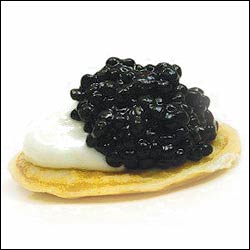So you saw in the papers that it’s illegal to import Russian and Iranian caviar into the United States. But you still need that fish-egg fix to pair with your holiday champagne and blinis. You went on the Web and discovered that they’re still selling Russian and Iranian caviar—for up to $3,200 a pound, true, which makes it moot for most of us. Still, what’s going on?
What’s going on is two things: supply and demand (that’s the $3,200 a pound part, which works out to $200 for an ounce, about enough for a light appetizer for two). The other thing is that caviar, while served raw, is heavily salted before it’s packed, and that, combined with the high oil content of fish eggs, keeps it fresh for months. The U.S. ban on caviar went into effect in October, so there’s still legal Iranian and Russian caviar in the pipeline, but by the first of the year, it’s bye-bye beluga.
Strictly speaking, the import of caviar from the two smaller, less-endangered sturgeon species in the Caspian and Black seas is still legal, but most legitimate importers are afraid to touch it, since the government could ban it at any moment, not to mention confiscate any supplies it suspects might be contraband. Sure, the importer might get it back if she or he can show a valid paper trail all the way back to the fishing boat, but by the time that happens, the stuff would probably no longer be fit to eat.
This is not quite the gourmet tragedy it seems. There are other kinds of sturgeon in the world, and most of them produce roe just as tasty as, though subtly different from, the Caspian kind. I’m not talking about the stuff a lot of high-end restaurants are pushing as a substitute these days. Like it or not—I don’t, particularly—paddlefish roe does not come from a sturgeon and doesn’t taste much like sturgeon eggs, either. The reason it’s offered is because it’s blackish, it looks like caviar, and it’s cheap enough wholesale to peddle even at a restaurant markup.
I’m not talking about salmon roe and other fish eggs, either. Some people like them, but they don’t taste, feel, or crunch like caviar, and they don’t work very well with the traditional caviar condiments, either. But you still have at least two real sturgeon alternatives. First, you can order wild but homegrown American caviar from “white” sturgeon native to the Missouri-Mississippi river system, which fanciers say tastes much like the delicate, buttery osetra caviar from the old country and costs about $15 an ounce before shipping and handling fees, or the farm-raised version of the same species, which depending on the grower and the dealer runs from $30 to $40 an ounce. Second, you can get the roe of the Iranian osetra species farm-raised from California starting at about $60 an ounce (what an ounce of Russian beluga cost in happier times).
If you’re determined to have imported caviar, you can get first-rate Siberian caviar from about $40 an ounce, but note that it doesn’t come from Siberia; it’s from a Siberian species farm-raised in Western Europe, and doesn’t taste any better than American white sturgeon roe to my mind. Save your money on the caviar and trade up your champagne from Bollinger to Krug, I say.
Caviar is a complicated and treacherous commodity. You should buy it only from a well-established dealer. Seattle Caviar Company (2833 Eastlake Ave. E., 206-323-3005, www.caviar.com) has reliably served the local restaurant and retail market for many years. There are innumerable Web sites offering overnight delivery on caviar and other roe. The more elaborately their products are documented, the more likely they are to treat you right. Tsar Nicoulai (www.tsarnicoulai.com) pioneered farm-raised osetra in California, but other firms are now competing with them. 911caviar.com still boasts the complete line of Caspian caviars, while they last.








